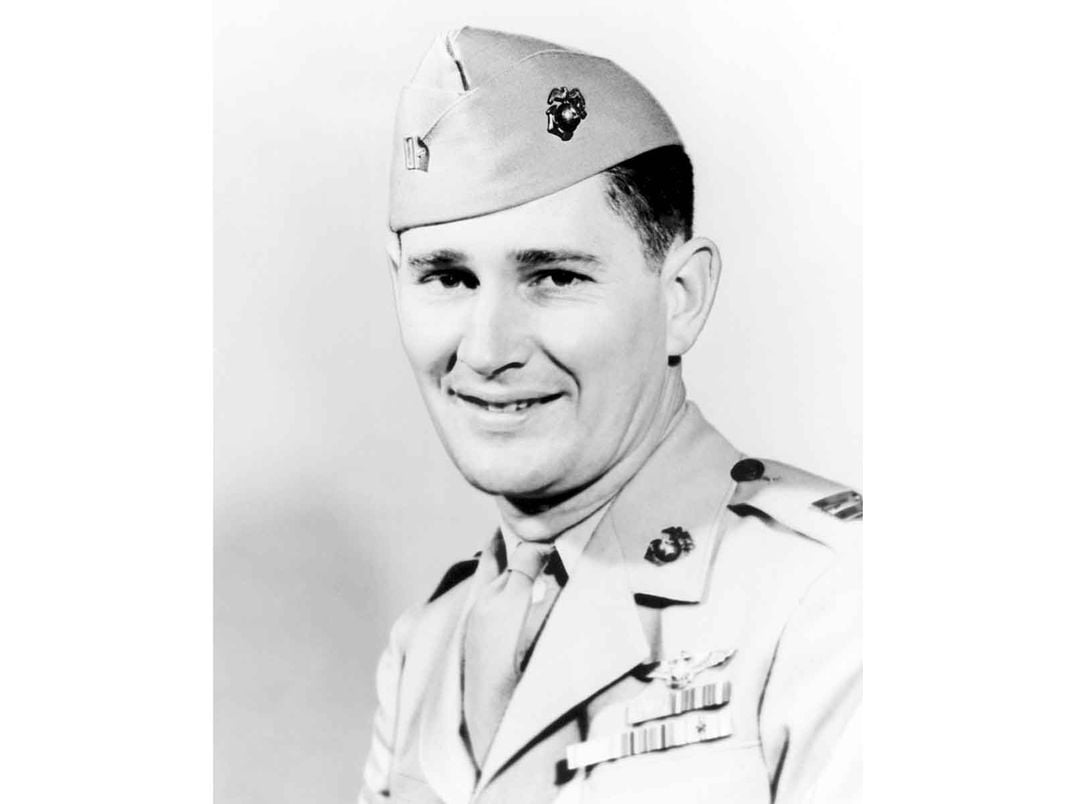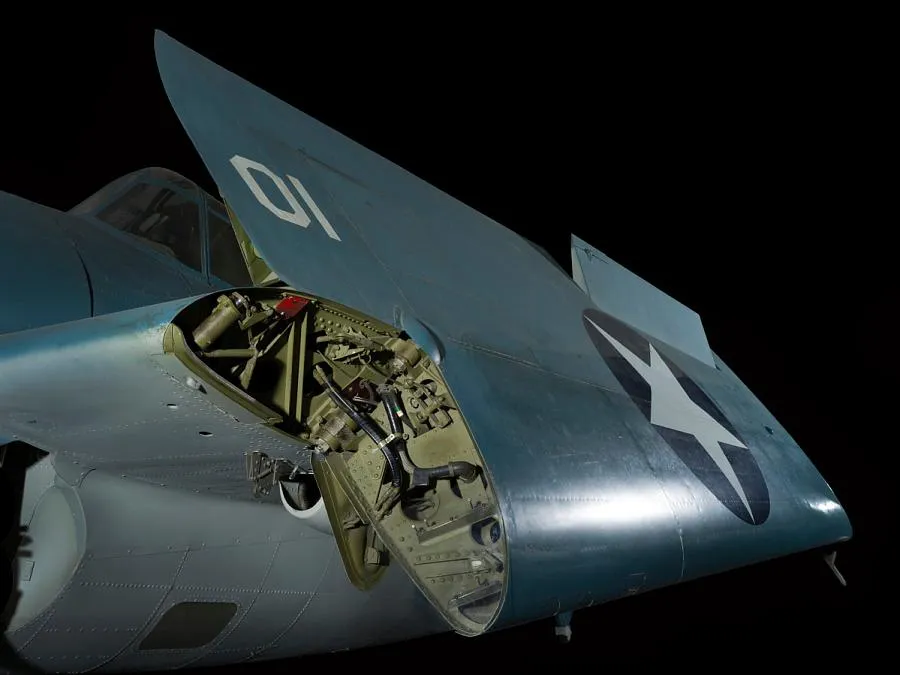How the Rugged F4F Wildcat Held the Line During World War II
Designed by Grumman Iron Works, the tough little fighter kept America in the fight during those early dark days in the Pacific Theater
/https://tf-cmsv2-smithsonianmag-media.s3.amazonaws.com/filer/98/5c/985c2d57-cf4b-4ee0-af37-6bbff8bfd0b0/untitled-1.jpg)
As Joe Foss scanned the skies on January 25, 1943, he spotted a large formation of 100 Japanese bombers and escort planes flying toward Guadalcanal. With only 12 fighters in his attack group, the Marine Corps captain recognized he was impossibly outnumbered.
That didn’t stop Foss, though. The cigar-chomping, tough-as-nails American ace with 26 kills in World War II gunned his Grumman F4F Wildcat into action and ordered his pilots to use the overcast conditions to their advantage as they attacked the overwhelming enemy force.
By darting in and out of the clouds, the aptly named Foss’ Flying Circus quickly shot down four Japanese fighters and tricked the bombers into thinking they had encountered a much larger squadron. The Japanese withdrew from attacking strategically important Henderson Field on Guadalcanal and flew back to their base without dropping a single bomb.
Foss was hailed for his heroics by saving the airbase with a “brilliant tactical maneuver” and would receive the Congressional Medal of Honor, which put him on the cover of Life Magazine. By equaling Capt. Eddie Rickenbacker’s First World War record of planes destroyed, Foss became America’s first “ace of aces.” Though his total would later be surpassed by other U.S. fighter pilots, Foss’ exploits came at a time when the outcome of the war was very much in doubt and the country desperately needed heroes.
“His remarkable flying skill, inspiring leadership and indomitable fighting spirit were distinctive factors in the defense of strategic American positions on Guadalcanal,” his citation read.
Foss answered the call of duty piloting the F4F Wildcat, a very capable carrier-based aircraft that saw service from the surprise attack at Pearl Harbor in 1941 to the Japanese surrender aboard the USS Missouri nearly four years later. While not as fast or nimble as other planes, it was surprisingly rugged and effective as a fighter in the hands of a trained pilot.
“The Wildcat was actually well-armored and very difficult for the Japanese to shoot down,” says Larry Burke, curator of U.S. naval aviation at the Smithsonian's National Air and Space Museum, which has a Wildcat in its collections that will go on view in the museum's new World War II gallery slated to open in 2024. “They had to put a lot of fire into it to knock it out. The Wildcat and other Grumman planes during the war acquired this reputation for sturdiness. One of the reasons the company was nicknamed Grumman Iron Works was because of the survivability of the planes,” says Burke.

And rugged it was. Despite the quickness and agility of the F4F’s main opponent in the Pacific Theater—the Japanese Mitsubishi A6M Zero—the Wildcat shot down an average of seven enemy aircraft for every one of its losses.
Foss scored his first kill in an F4F during his first combat mission on October 13, 1942. However, his Wildcat was also severely shot up and was being chased by three Zeros. He was forced to land at Henderson Field at full speed with a dead engine and no flaps. Nearly a month later, on November 7, another Wildcat flown by Foss was hit hard, forcing him to ditch at sea. He survived both incidents with no major injuries. In fact, Foss was shot down at least four more times and got back in the cockpit after each one.
Bigger and better fighters—such as the Grumman F6F Hellcat—would enter the fray, but the F4F Wildcat saw service throughout the war. Its durability, along with multiple .50-caliber machineguns and wing space for two 100-pound bombs, made it ideal for search-and-destroy missions. Plus, it possessed another feature that worked wonders onboard the smaller escort carriers often used in convoys.
“(Company co-founder) Leroy Grumman very famously experimented with an eraser and unfolded paperclip to come up with a diagonal hinge that he called the Sto-Wing,” Burke says. “It allowed the wing to fold alongside the aircraft, kind of like a bird’s wing, which permitted more planes to be stored on the escort carriers.
“What’s fascinating is the wing is still in use today,” says Burke. The E-2 Hawkeye, the Navy’s early-warning aircraft, features the Sto-Wing because the aircraft has a big radome on top that interferes with the upward-folding wings on other aircraft.

The Wildcat at the National Air and Space Museum is a version of the Grumman F4F-4, known as an Eastern Division FM-1. It was actually produced under license by General Motors, which began manufacturing Wildcats in 1943 when Grumman switched over to F6F Hellcats. While this plane never saw combat, it is a well-preserved example of the aircraft that helped turn the tide in the Pacific.
“The Wildcat was the airplane that held the line for the Navy at the beginning of World War II,” Burke says. “It held on in combat until better aircraft could be designed and put into service. It was the primary fighter operated by the U.S. Navy and Marine Corps.
“The Wildcat was the main fighter used in four of the first five big carrier battles of World War II. And it continued to make a mark later in the war by flying from the convoy escort carriers, which the bigger planes couldn’t do,” says Burke.
During World War II, Joe Foss scored all 26 of his victories flying the F4F, including his last three kills in a single day. He would go on to serve at age 39 as the youngest governor in South Dakota history, first commissioner of the upstart American Football League in 1959 and was a passionate gun-rights advocate as president of the National Rifle Association from 1988 to 1990. Foss died in 2003 at the age of 87.
Wherever he went later in life, the Wildcat was never far from his heart. The Medal of Honor fighter pilot developed a strong affinity for the rugged aircraft that protected him and propelled him to victory at a critical moment in history.
“I loved that Grumman F-4F Wildcat,” Foss once told an interviewer. “I just loved it. It was like a brother to me. It was tough, and I would be able to destroy the enemy with it, and I couldn’t blame it for the speed it didn’t have, but I felt at home.”
/https://tf-cmsv2-smithsonianmag-media.s3.amazonaws.com/accounts/headshot/dave.png)
/https://tf-cmsv2-smithsonianmag-media.s3.amazonaws.com/accounts/headshot/dave.png)